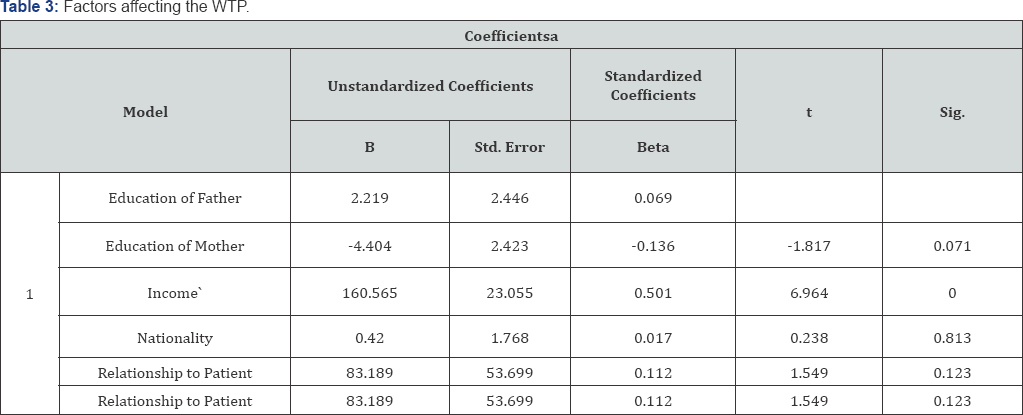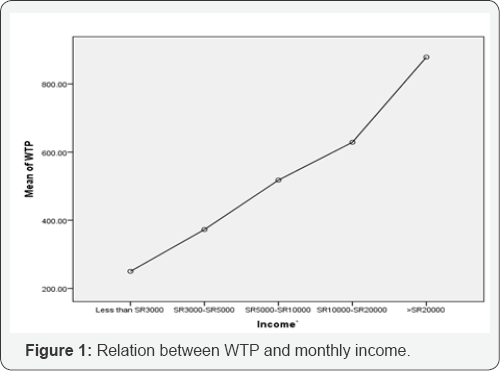Willingness of Parents to Pay for Space Maintainer Therapy for their Children- Juniper Publishers
Juniper Publishers- Open Access Journal of Dentistry & Oral Health
Abstract
Background and Objective: Space maintainers are the most commonly used tools of interceptive orthodontics. Since their benefit is not immediately visible to the parents there is the possibility that they would not be willing to pay for interceptive care.
Methodology: 155 families of children who had lost a primary tooth prematurely participated in the study. A short description of the potential benefits of space-maintainers, parents were asked if they are willing to pay the median cost, Parents who are unwilling to pay the median price will have the price reduced by 50 SR until they reached a price they would be willing to pay and for parents who are willing to pay the median price had the price progressively increased by 50 SR until they were no longer willing to pay.
Results and conclusion: The results of the study showed that Parents education, nationality and relationship to the patient was not statistically significant, however Family monthly income and WTP value for the space maintainer were associated.
Keywords: Space maintainers; Willing to pay; Interceptive orthodontics; Dental economics; Bidding
Introduction
Interceptive orthodontics is an important method ofpreventing extensive malocclusion and often-costly orthodontic care. Space maintainers are the most commonly used tools of interceptive orthodontics. Given that the benefits of space maintenance are not immediately visible to the parents there is the possibility that they would not be willing to pay for interceptive care.
In the past few decades there has been a great interest in the field of dental economics with authors seeking to estimate the cost effectiveness of several treatments [1-3]. The concept that delaying dental care results in increased costs is only now being scientifically evaluated [4].
Assessing a patient's willingness to pay (WTP) is one of the most accepted methods to evaluate the acceptability of new treatment modality for the clinician. It has been used to successfully measure patient's perception in not only in dentistry [1,4,5], also in medical field such as orthopedics [6] cardiology and health care service preferences (Fu et al 2004).
Bidding is the oldest and most accepted tool to assess WTP of a patient and provides both clinicians and third party payment providers with a realistic estimate of how much a patient can spend on a treatment modality (McName et al 2004).
The aim of this study was to evaluate the willingness of parents to pay for space maintainers in Riyadh City in Saudi Arabia.
Methodology
The sample comprised of 155 Parents of children aged between 5 and 9 years who have undergone extraction of at least one primary tooth presenting to the dental clinics of the Riyadh Colleges of Dentistry and Pharmacy
Bidding process
Four investigators were trained for the bidding process for data collection and calibrated against the lead investigator (SCP).
Conducting the bidding
Parents who consent to participate in the study was given a form in Arabic asking them to fill in their demographic data, the bidding process administered in a two-stage process.
Stage 1: Description of the potential benefits of space- maintainers and then the parents were asked if they are willing to pay the median cost of the space maintainer needed for their child in Riyadh city, which is 600SR.
Stage 2: The parents were allowed to bid for the price they would be willing to pay. Parents who are unwilling to pay the median price will have the price reduced by 50 SR until they reach a price they would be willing to pay or the amount reaches 0 SR. Parents who are willing to pay the median price had the price progressively increased by 50 SR and asked if they would still be willing to pay for the space maintainer, the price will be progressively increased until the parents is longer willing to pay or until they reach the maximum price charged for space maintainer in Riyadh city, whichis1800 SR.
Statistical analyses: All statistical analyses was done using SPSS ver 22 data processing software (IBM Corp, Armonk NY,USA). Apart from descriptive statistics, linear regression models will be developed to determine the factors that influence the willingness to pay for space maintainers.
Results
A total of 155 families were able to participate in the study, the sample compromised of 44 Fathers, 97 mothers and 14 who is related to the child in other way (Table 1).

Factors affecting WTP
Majority of parents shows their willingness to pay for the space maintainer (Table 2).


Factors that could affect the WTP were calculated by using a linear regression model to determine the significant difference ( Table 3). Parents education, nationality and relationship to the patient was not statistically significant, however Family monthly income and WTP value for the space maintainer were associated (Figure 1).

Discussion
Parents preference is rather new in the field of space maintainer research and while WTP is likely to be a preferable method of utility, and as the present study indicates is feasible to conduct despite being time consuming. Bidding is the oldest and most widely used WTP method among the different approaches and has the advantage over other methods of being able to provide a guide on a realistic amount.
Space maintainers are an essential part of interceptive orthodontic treatment. In this study parents were asked about their willingness to pay for a space maintainer, however no effort was made to educate the patient prior to the bidding process. The reason for doing this was to make sure that a baseline score on the willingness to pay was available. In future research we hope to look into the effect of educating the parent on the benefits of space-management on their willingness to pay.
Monthly income has constantly been a factor that influences willingness to pay, some studies have also shown that education of the parent and awareness of the problem can play a role in the WTP for orthodontic treatment. However, the fact that demographic variables such as the parent's education or nationality played no role in the WTP for space maintainers suggests that the importance given to space maintainers is lower than that given to fixed orthodontic treatment. This fact is further supported by the fact that the WTP value in this study approximated to only around half of the market price for space maintainer to preserve the space for the permanent teeth.
Conclusion
Monthly income was the only factor affects the parent willingness to pay for the space maintainer. There was no statistically significant difference in parent's education, nationality and relationship to the child with the willingness to pay for the space maintainer.
For more Open Access Journals in Juniper Publishers please click on: https://juniperpublishers.com/aboutus.php
For more articles in Open Access Journal of Dentistry & Oral Health please click on:
To know more about Open Access Journals please click on: https://juniperpublishers.com/journals.php


Comments
Post a Comment